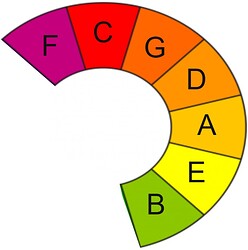Let’s push on and try another major scale.
Ab major may not be the most guitar-friendly but E major surely is right?
The blues in E.
Come on!
Everyone’s played the blues in E.
Yeah!
E major scale

Let’s find those notes on the Circle of Fifths.
Well damn and blast!
Where the heck are those notes?
Are we being led a merry dance along a blind alley here?
Well … no, not exactly.
But we do need to think carefully.
Only one sharp note is shown on the Circle of Fifths as presented so far. And it is F# at the six o’clock position, the enharmonic with Gb. All for the reasons discussed previously when we placed the four note clusters in their overlapping positions. But we need to always be mindful that all notes can be named by an enharmonic equivalent. Which means all remaining flat notes around the Circle of Fifths can be given a second name.
Bb = A#
Eb = D#
Ab = G#
Db = C#
With those inclusions we can view the Circle of Fifths with a more complete set of labels.
We should now be able to quickly find the seven notes of the E major scale, knowing that they will all be in consecutive positions. We should also now be anticipating that E is the second note when reading clockwise. And indeed it is. We find these notes.
Do we get the same (seemingly) random ordering of scale degrees too?

Yes.
Yes we do.
That is quite the thing isn’t it?
Random turns out not to be random but extremely consistent and predictable.










